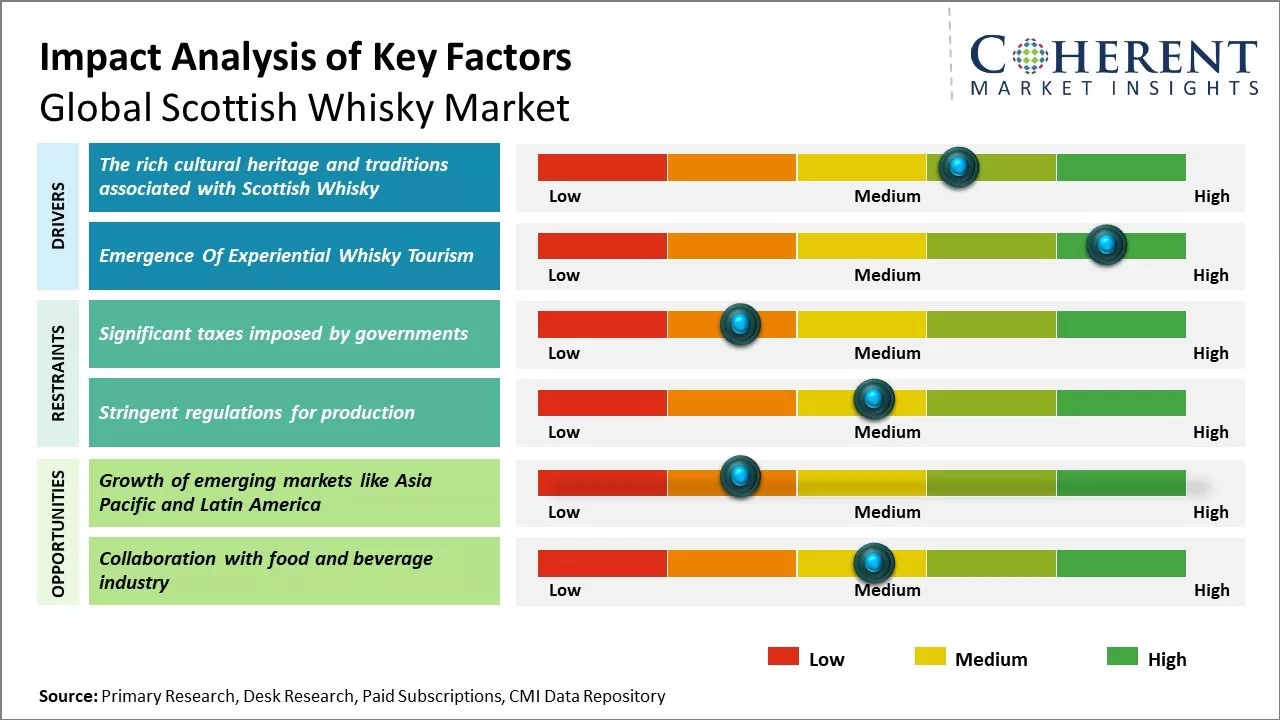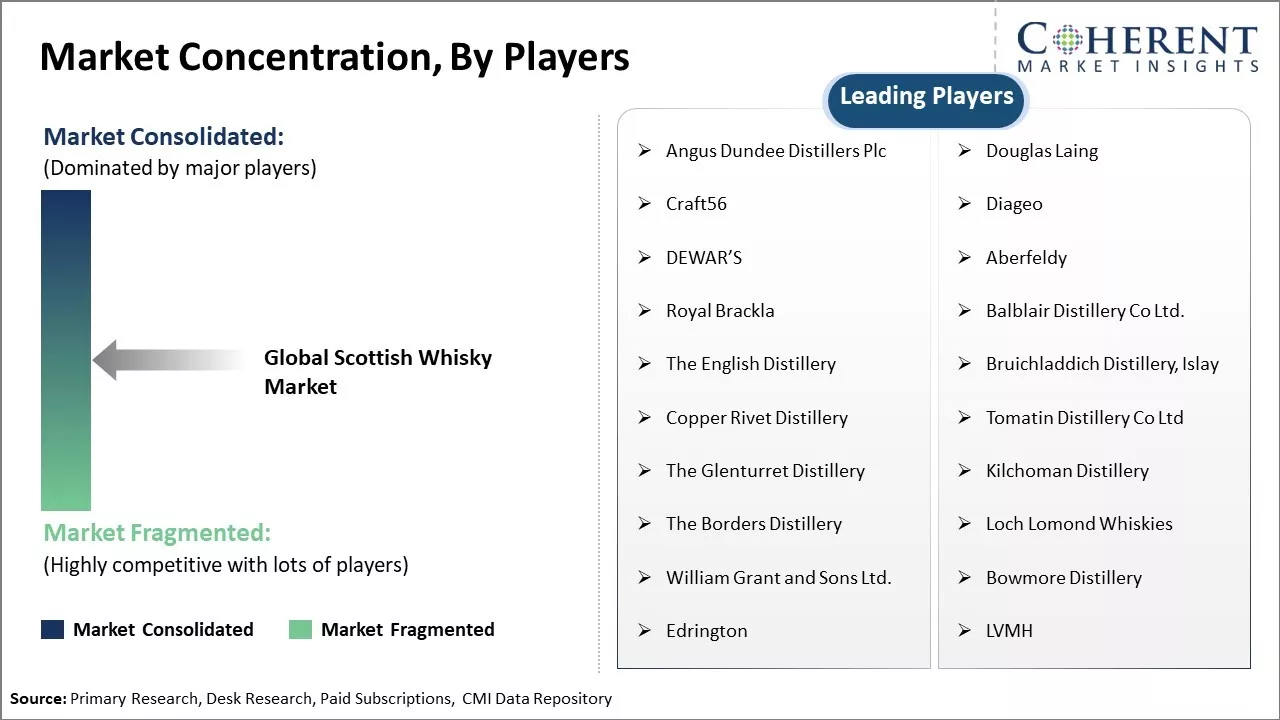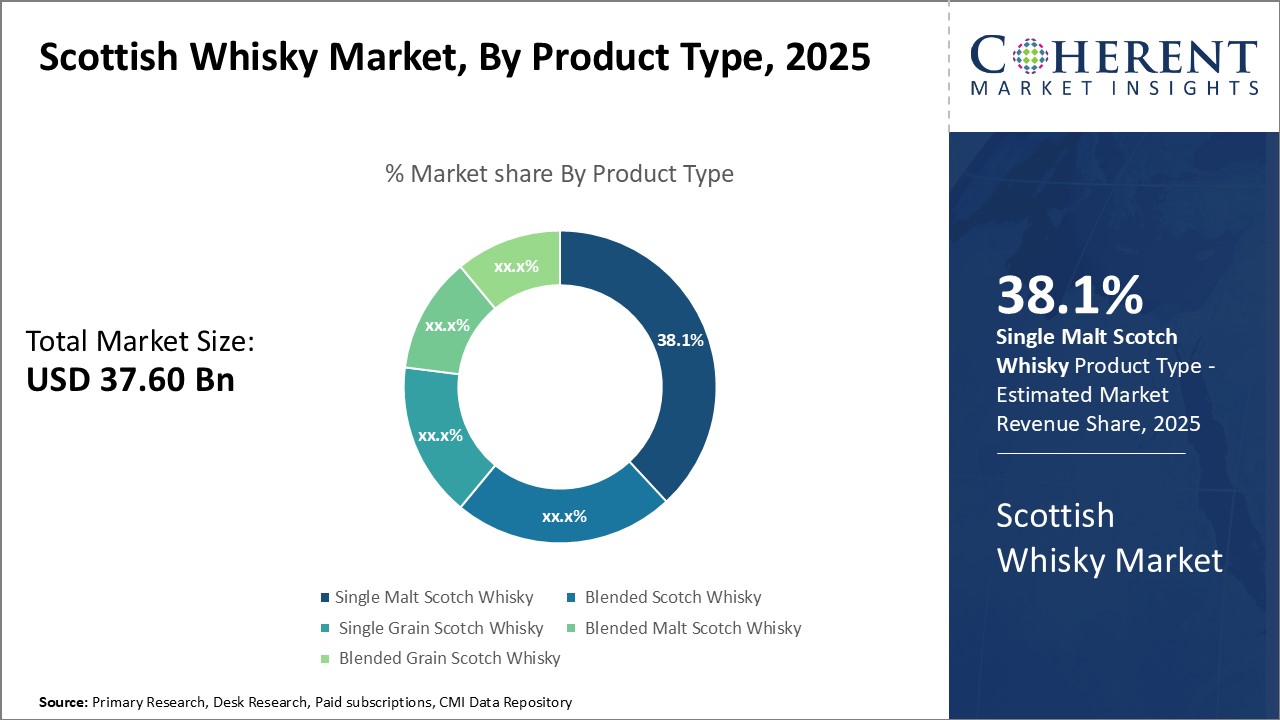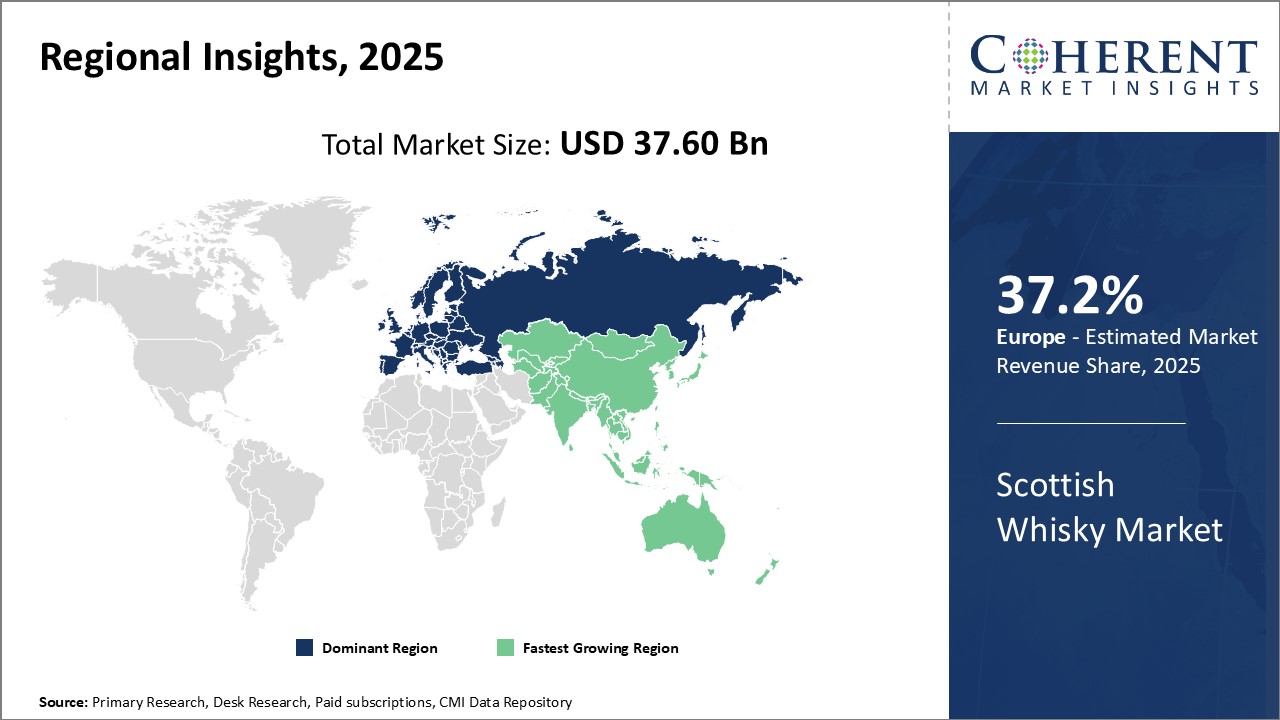The Scottish whisky market is estimated to be valued at USD 37.60 Bn in 2025 and is expected to reach USD 61.61 Bn by 2032, exhibiting a compound annual growth rate (CAGR) of 7.3% from 2025 to 2032.

Discover market dynamics shaping the industry: Download Free Sample
The market has been growing steadily over the past few years driven by rises in disposable income and increasing social media influence. Younger consumers are increasingly experimenting with premium spirits like whisky and are open to newer flavor profiles. The on-trade channel which includes bars, restaurants, and hotels has also aided growth through novel whisky-based cocktails and experiences. The Scottish whisky market is projected to experience steady growth over the forecast period. Rising global appreciation for single malt Scotch whisky and innovative campaigns by leading distillers to attract new and younger consumers will aid market expansion. Additionally, the increasing popularity of on-premise consumption experiences and novel small-batch and craft offerings will support ongoing market gains through 2032.
The rich cultural heritage and traditions associated with scottish whisky
The rich cultural heritage and traditions associated with Scottish Whisky have made it an iconic drink both within the country and beyond its borders. Whisky production and consumption is deeply embedded within Scottish culture and social life. Traditional whisky distilleries dot the landscape of Scotland, paying homage to centuries of whisky making traditions and practices passed down through generations. Beyond being just a popular alcoholic beverage, Scottish Whisky has come to represent the very essence of Scottish identity, pride and spirit across the world. Generations of Scottish families have been involved in whisky production, imparting robustness and quality to the product. The cultural significance attached to Scottish Whisky has transformed it into a global ambassador of Scottish culture and a reason for both local and foreign visitors to explore the whisky trails of Scotland. This deep cultural association drives continuous interest in Scottish Whisky, even amongst consumers who may not be regular whisky drinkers. The cultural iconic status of Scottish Whisky is a formidable driver that continues to attract consumers within and outside of Scotland.

Get actionable strategies to beat competition: Download Free Sample
Emergence of Experiential Whisky Tourism
Over the past decade, there has been a marked rise in experiential whisky tourism within Scotland. People are showing keen interest to visit whisky distilleries and learn about the unique whisky making processes, history, cultural importance, and appreciate the different expressions. Whisky tourism allows people to interact with the people behind their favorite drams and understand what makes Scottish Whisky truly special. Many distilleries have reinvented themselves as tourist attractions, offering guided tours, educational experiences, food pairing opportunities, and opportunities to blend whisky. Some of the most renowned distilleries receive tourists throughout the year, sustaining the local economies. The emergence of experiential whisky tourism has been a strong driver for Scottish Whisky, as it fosters deeper connections for consumers with the provenance, heritage and passion behind every bottle. By stimulating the senses and engaging visitors at various levels, experiential tourism is ensuring that interest in Scottish Whisky sustains for future generations as well.
Key Takeaways from Analyst:
The Scottish whisky market continues to see steady growth driven by the strong global demand. One of the key drivers is the rising popularity of single malt whiskies in developed markets like the U.S. and Japan.
High excise taxes imposed on spirits by some governments pose a restraint. The ongoing U.K.-EU trade negotiations related to Brexit also introduce uncertainty that could impact trade. Within Scotland, the Speyside region has dominated Scottish whisky production for decades owing to favorable climate and soil conditions.
North American markets are expected to remain the most lucrative for Scottish distillers. Nonetheless, Asian markets like China present the biggest potential for future expansion given their huge populations and rising affluence. Overall, the long-term outlook for Scotch whisky appears quite positive assuming prevailing trends of growing global interest in premium spirits and experiential consumption continue unabated.
Market Challenges: Significant taxes imposed by governments
The significant taxes imposed by various governments around the world are posing considerable challenges for the growth of the global Scottish whisky market. High taxation has made Scottish whisky quite expensive in several international markets, thereby restricting its mass consumption. With overall beverage alcohol consumption rising globally in recent years, the Scottish whisky industry is unable to capture this growth fully and scale up its operations at a more rapid pace. Additionally, The high cost of Scottish whisky consequent to disproportionate taxation is also compelling distillers to cut costs drastically and compromise on quality standards to maintain profitability. This eventually affects the premium brand image and heritage value attached with prestigious whisky names from Scotland. While governments aim to curb harmful drinking through taxes, excessively high duties beyond a reasonability threshold tend to promote counterfeiting and smuggling rather than moderate consumption behavior. Overall, exorbitant whisky taxation by multiple governments in import markets across continents like Asia, Africa, North America and Europe is restricting the global growth trajectory of the revered Scottish spirits industry in the long run, despite rising global interest in premium alcohol beverages.
Market Opportunities: Growth of emerging markets like Asia Pacific and Latin America
The growth of emerging markets in Asia Pacific and Latin America regions provide significant opportunities for the global Scottish whisky market going forward. These regions have seen rapid economic development and rise of large middle class consumer bases in recent decades. Countries like India, China, Brazil and others have more than double digit GDP growth rates annually as per World Bank data from 2020-21. This directly translates to higher disposable incomes for common consumers in these markets. As people get more affluent, their spending on luxury and premium goods increases considerably. Scottish whisky, being a premium beverage associated with high social status, stands to greatly benefit from this change in consumption patterns of new middle class customers in Asia Pacific and Latin America.

Discover high revenue pocket segments and roadmap to it: Download Free Sample
Insights, by Product Type: Tradition of Blended Scotch Whisky
In terms of product type, blended Scotch whisky is expected to contribute 38.1% share of the market in 2025, owing to its traditional appeal and widespread popularity. Blended Scotch is seen as an accessible style of whisky that maintains the core characteristics associated with Scotch. Its blended nature produces a smooth and approachable whisky that appeals to both casual drinkers as well as those developing their tastes. Many blended Scotch brands have been crafted over decades through perfecting recipes that highlight familiar flavors. Their consistent products have built a legacy of tradition that reassures customers and adds to their perception as reliable choices. The blended category also offers more affordable options compared to single malts or grains, expanding its customer base. With brands marketed around familiarity, tradition and accessibility, blended Scotch whisky has remained a mainstay in both the Scottish and global whisky markets.
Insights, by Price Range: Premium Quality at an Attainable Price
In terms of price range, the premium segment is expected to contribute 35% share of the market in 2025, as it is appealing to customers seeking higher quality whisky without spending top dollar. The premium segment strikes a balance by delivering whiskies that showcase attention to detail in production while staying within reach for a wider range of budgets. These whiskies excel at craftsmanship yet maintain relatively approachable price tags through economies of scale. Their affordable premium status makes them a popular choice for gift-giving or everyday drinking among whisky appreciators. Customers view premium priced whisky as a higher quality step up from basic offerings without compromising value. As such, the segment satisfies those developing sophisticated tastes without requiring an ultra-premium budget. This broad appeal and sweet spot in price versus quality has contributed greatly to the dominance of the premium segment.
Insights, by Distribution Channel: Tradition of the On-Trade Experience
In terms of distribution channel, the on trade segment is expected to contribute 36.1% share in 2025, due to strong connections to Scottish culture and hospitality. Sharing a drink in the local pub holds deep tradition in Scotland as a social gathering. On trade venues cultivate an experience beyond just consumption by enhancing the whisky with atmosphere, history, and community. Pubs showcase local Scottish heritage through wood paneling, artifacts, and staff well-versed in the whisky they serve. Customers enjoy exploring new drams in these authentic settings. They also gain exposure to whisky brands primarily found in the on trade segment. This traditional social aspect and sense of discovery drives repeat visits and loyalty to whisky-focused establishments. In turn, on trade accounts remain the lifeline for many distilleries seeking to reach customers organically immersed in the whisky lifestyle. The vibrant pub culture keeps the traditions of Scottish whisky thriving.

Need a Different Region or Segment? Download Free Sample
The Scottish whisky market is a powerhouse in the global spirits industry, with a rich heritage and a steadfast dedication to quality. As of 2025, the European region has emerged as the dominant force, commanding a 37.2% share of the global market. However, the Asia Pacific region has emerged as the fastest-growing market, presenting significant opportunities for Scottish whisky producers. Europe's stronghold in the Scottish whisky market can be attributed to several factors. Historically, the region has been the primary consumer of Scotch whisky, with a deep-rooted appreciation for the spirit's unique flavors and craftsmanship. Additionally, the European Union's regulations and protections, such as the Geographical Indication (GI) for Scotch whisky, have helped to maintain the integrity and reputation of the product, further solidifying Europe's position.
While Europe remains the dominant market, the Asia Pacific region is witnessing a remarkable surge in demand for Scottish whisky. Factors such as rising disposable incomes, a growing middle class, and a burgeoning interest in premium spirits have contributed to the region's rapid growth. Countries like China, Japan, and India have emerged as particularly promising markets, with consumers increasingly embracing the unique flavors and heritage of Scotch whisky. The global expansion of the Scottish whisky market presents both opportunities and challenges for producers. On the one hand, the growing demand in Asia Pacific and other emerging markets offers the potential for significant growth and diversification of the customer base. On the other hand, the industry must navigate the complexities of navigating different cultural preferences, regulatory environments, and distribution channels across diverse regions.
Scottish Whisky Market Report Coverage
| Report Coverage | Details | ||
|---|---|---|---|
| Base Year: | 2024 | Market Size in 2025: | USD 37.60 Bn |
| Historical Data for: | 2020 To 2024 | Forecast Period: | 2025 To 2032 |
| Forecast Period 2025 to 2032 CAGR: | 7.3% | 2032 Value Projection: | USD 61.61 Bn |
| Geographies covered: |
|
||
| Segments covered: |
|
||
| Companies covered: |
Angus Dundee Distillers Plc, Douglas Laing, Craft56, Diageo , DEWAR’S, Aberfeldy, Royal Brackla, Balblair Distillery Co Ltd., The English Distillery, Bruichladdich Distillery, Islay, Copper Rivet Distillery, Tomatin Distillery Co Ltd, The Glenturret Distillery , Kilchoman Distillery, The Borders Distillery, Loch Lomond Whiskies, William Grant and Sons Ltd., Bowmore Distillery, Edrington, and LVMH |
||
| Growth Drivers: |
|
||
| Restraints & Challenges: |
|
||
Uncover macros and micros vetted on 75+ parameters: Get instant access to report
*Definition: The Scottish whisky market consists of the distribution and sales of single malt Scotch whisky that is produced in Scotland. It features renowned brands such as Glenfiddich, The Balvenie, Aberlour, and Macallan that produce fine single malts in small batches using traditional Scottish distilling methods. The market caters to whisky connoisseurs around the world looking to purchase quality single malts directly from Scotland or through distributor networks globally.
Share
Share
About Author
Yash Doshi is a Senior Management Consultant. He has 12+ years of experience in conducting research and handling consulting projects across verticals in APAC, EMEA, and the Americas.
He brings strong acumen in helping chemical companies navigate complex challenges and identify growth opportunities. He has deep expertise across the chemicals value chain, including commodity, specialty and fine chemicals, plastics and polymers, and petrochemicals. Yash is a sought-after speaker at industry conferences and contributes to various publications on topics related commodity, specialty and fine chemicals, plastics and polymers, and petrochemicals.
Missing comfort of reading report in your local language? Find your preferred language :
Transform your Strategy with Exclusive Trending Reports :
Frequently Asked Questions
Joining thousands of companies around the world committed to making the Excellent Business Solutions.
View All Our Clients